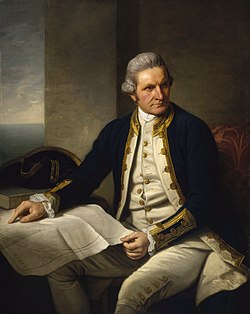Captain James Cook, FRS (October 27, 1728 (O.S.) – February 14, 1779)
English explorer, navigator and cartographer. He made three voyages to the Pacific Ocean, accurately charting many areas and recording several islands and coastlines on European maps for the first time. His most notable accomplishments were the British discovery and claiming of the east coast of Australia; the European discovery of the Hawaiian Islands; and the first recorded circumnavigation and mapping of Newfoundland and New Zealand. Cook died in Hawaii in a fracas with Hawaiians during his third exploratory voyage in the Pacific in 1779.

First Voyage
In 1766, the Royal Society hired Cook to travel to the Pacific Ocean to observe and record a transit of Venus across the Sun. Cook was commissioned as a Lieutenant and given command of HM Bark Endeavour. He sailed from England in 1768, rounded Cape Horn and continued westward across the Pacific to arrive at Tahiti on April 13, 1769, where the observations were to be made. The transit was scheduled to occur on June 3, and in the meantime he commissioned the building of a small fort and observatory.
Cook lost not a single man to scurvy, a remarkable and practically unheard-of achievement in 18th century long-distance sea-faring. Adhering to Royal Navy policy introduced in 1747, Cook persuaded his men to eat foods such as citrus fruits and sauerkraut. At that time it was known that poor diet caused scurvy but not specifically that a Vitamin C deficiency was the culprit.
The Endeavour, his ship on this first voyage, would later lend its name to the Space Shuttle Endeavour, as well as the Endeavour River.
Cook's journals were published upon his return, and he became something of a hero among the scientific community. Among the general public, however, the aristocratic botanist Joseph Banks was a bigger hero. Banks even attempted to take command of Cook's second voyage, but removed himself from the voyage before it began.
Second Voyage
Shortly after his return, Cook was promoted from Lieutenant to Commander (correctly "Master and Commander"). Then once again he was commissioned by the Royal Society to search for the mythical Terra Australis. On his first voyage, Cook had demonstrated by circumnavigating New Zealand that it was not attached to a larger landmass to the south; and although by charting almost the entire eastern coastline of Australia he had shown it to be continental in size, the Terra Australis being sought was supposed to lie further to the south. Despite this evidence to the contrary Dalrymple and others of the Royal Society still believed that this massive southern continent should exist.
Cook commanded HMS Resolution on this voyage, while Tobias Furneaux commanded its companion ship, HMS Adventure. Cook's expedition circumnavigated the globe at a very high southern latitude, becoming one of the first to cross the Antarctic Circle on January 17, 1773, reaching 71°10' south. He also discovered South Georgia and the South Sandwich Islands. In the Antarctic fog, the Resolution and Adventure became separated. Furneaux made his way to New Zealand, where he lost some of his men following a fight with the Māori, and eventually sailed back to Britain, while Cook continued to explore the Antarctic.
Third Voyage
On his last voyage, Cook once again commanded HMS Resolution, while Captain Charles Clerke commanded HMS Discovery. Ostensibly the voyage was planned to return Omai to Tahiti; this is what the general public believed, as he had become a favourite curiosity in London. After returning Omai, Cook travelled north and in 1778 became the first European to visit the Hawaiian Islands, which, in passing and after initial landfall in January 1778 at Waimea harbor, Kauai, he named the "Sandwich Islands" after the 4th Earl of Sandwich, the acting First Lord of the Admiralty.
From there, he travelled east to explore the west coast of North America, eventually landing near the First Nations village at Yuquot in Nootka Sound on Vancouver Island, although he unknowingly sailed past the Strait of Juan de Fuca. He explored and mapped the coast from California all the way to the Bering Strait, on the way discovering what came to be known as Cook Inlet in Alaska.
On February 14 at Kealakekua Bay, some Hawaiians stole one of Cook's small boats. In the ensuing skirmish, shots were fired at the Hawaiians but their woven war shields protected them, and Cook's men had to retreat to the beach. As Cook turned his back to help launch the boats, he was struck on the head by the villagers and then stabbed to death[3] as he fell on his face in the surf. The Hawaiians dragged his body away. The esteem in which the Captain was nevertheless held by the natives resulted in his body being retained by their chiefs and elders (possibly for partial human consumption, though this assertion remains contentious) and the flesh cut and roasted from his bones. Indeed some of Cook's remains, disclosing some corroborating evidence to this effect, were eventually returned to the British for a formal burial at sea following an appeal by the crew.[4]
Clerke took over the expedition and made a final attempt to pass through the Bering Strait. The Resolution and Discovery finally returned home in 1780.

Red-First Voyage; Green-Second; Blue-Third
The details of his voyage are too numerous to mention here; a more complete account can be found at Wikipedia, or other online resources.

No comments:
Post a Comment